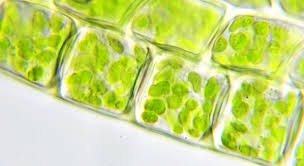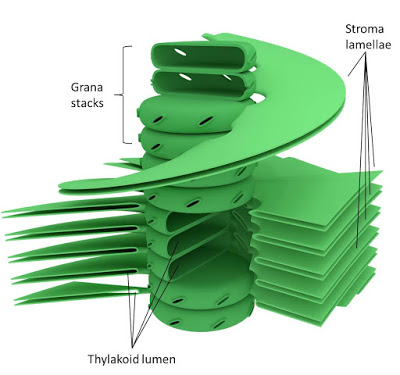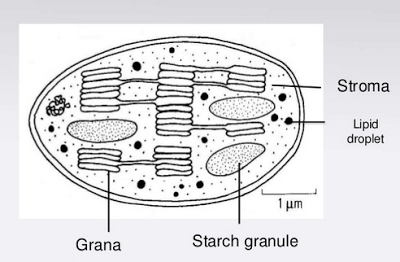Biology
 Photosynthesis takes place inside chloroplasts.
Photosynthesis takes place inside chloroplasts.
These are organelles surrounded by 2 membranes, called an envelope.

Chloroplasts are found in mesophyll cells in leaves:
- Palisade mesophyll cells contain most chloroplasts.
- Spongy mesophyll cells and Guard cells also contain chloroplasts.

The membranes inside a chloroplast are called lamellae, and it is here that the light-dependent
reactions take place. The membranes contain chlorophyl molecules, arranged in groups called photosystems. There are two kinds of photosysterns, PSI and PSII, each of which contains slightly different kinds of chlorophyll.

There are enclosed spaces between pairs of membranes, forming fluid-filled sacs called thylakoids. These are involved in photophosphorylation - the formation of ATP using energy from light. Thylakoids are often arranged in stacks called grana (singular: granum),

Stroma and light-independent reactions
The 'background material' of the chloroplast is called the stroma, and this is where the light-independent reactions take place.
Chloroplasts often contain starch grains and lipid droplets. These are stores of energy-containing substances that have been made in the chloroplast but are not immediately needed by the cell or by other parts of the plant.

- #104 Separating Chlorophyll Pigments By Thin Layer Chromatography (tlc)
Chromatography is a method of separation that relies on the different solubilities of different solutes in a solvent. A mixture of chlorophyll pigments is dissolved in a solvent, and then a small spot is placed onto chromatography paper. The solvent gradually...
- # 102 The Light-dependent Reactions, Photophosphorilation
Chlorophyll molecules in photosystern I (PSI) and photosystern II (PSII) absorb light energy. The energy excites electrons, raising their energy level so that they leave the chlorophyll. The chlorophyll is said to be photo-activated. PSII contains...
- #101 Photosynthetic Pigments
Photosynthetic pigments are pigments presented in chloroplasts or photosynthetic bacteria. They capture light energy necessary for photosynthesis and convert it to chemical energy. PigmentsA pigment is any substance that absorbs light.The color...
- #99 Photosynthesis Overview
Photosynthesis is a series of reactions in which energy transferred as light is transformed to chemical energy. Energy from light is trapped by chlorophyll, and this energy is then used to ? split apart the strong bonds in water molecules to release...
- #98 Photosynthesis Syllabus
13.1 Photosynthesis as an energy transfer process 13.2 Investigation of limiting factors 13.3 Adaptations for photosynthesis Photosynthesis is the energy transfer process that is the basis of much of life on Earth....
Biology
#100 Chloroplasts

These are organelles surrounded by 2 membranes, called an envelope.

Chloroplasts are found in mesophyll cells in leaves:
- Palisade mesophyll cells contain most chloroplasts.
- Spongy mesophyll cells and Guard cells also contain chloroplasts.

Lamellae and light-dependent reactions
The membranes inside a chloroplast are called lamellae, and it is here that the light-dependent
reactions take place. The membranes contain chlorophyl molecules, arranged in groups called photosystems. There are two kinds of photosysterns, PSI and PSII, each of which contains slightly different kinds of chlorophyll.

There are enclosed spaces between pairs of membranes, forming fluid-filled sacs called thylakoids. These are involved in photophosphorylation - the formation of ATP using energy from light. Thylakoids are often arranged in stacks called grana (singular: granum),

The 'background material' of the chloroplast is called the stroma, and this is where the light-independent reactions take place.
Chloroplasts often contain starch grains and lipid droplets. These are stores of energy-containing substances that have been made in the chloroplast but are not immediately needed by the cell or by other parts of the plant.

Syllabus: 13.1 Photosynthesis as an energy transfer process Light energy absorbed by chloroplast pigments in the light dependent stage of photosynthesis is used to drive reactions of the light independent stage that produce complex organic compounds. Chromatography is used to identify chloroplast pigments and was also used to identify the intermediates in the Calvin cycle. a) explain that energy transferred as ATP and reduced NADP from the light dependent stage is used during the light independent stage (Calvin cycle) of photosynthesis to produce complex organic molecules b) state the sites of the light dependent and the light independent stages in the chloroplast c) describe the role of chloroplast pigments (chlorophyll a, chlorophyll b, carotene and xanthophyll) in light absorption in the grana d) interpret absorption and action spectra of chloroplast pigments e) use chromatography to separate and identify chloroplast pigments and carry out an investigation to compare the chloroplast pigments in different plants (reference should be made to Rf values in identification) f) describe the light dependent stage as the photoactivation of chlorophyll resulting in the photolysis of water and the transfer of energy to ATP and reduced NADP (cyclic and non-cyclic photophosphorylation should be described in outline only) g) outline the three main stages of the Calvin cycle: ? fixation of carbon dioxide by combination with ribulose bisphosphate (RuBP), a 5C compound, to yield two molecules of GP (PGA), a 3C compound ? the reduction of GP to triose phosphate (TP) involving ATP and reduced NADP ? the regeneration of ribulose bisphosphate (RuBP) using ATP h) describe, in outline, the conversion of Calvin cycle intermediates to carbohydrates, lipids and amino acids and their uses in the plant cell |
- #104 Separating Chlorophyll Pigments By Thin Layer Chromatography (tlc)
Chromatography is a method of separation that relies on the different solubilities of different solutes in a solvent. A mixture of chlorophyll pigments is dissolved in a solvent, and then a small spot is placed onto chromatography paper. The solvent gradually...
- # 102 The Light-dependent Reactions, Photophosphorilation
Chlorophyll molecules in photosystern I (PSI) and photosystern II (PSII) absorb light energy. The energy excites electrons, raising their energy level so that they leave the chlorophyll. The chlorophyll is said to be photo-activated. PSII contains...
- #101 Photosynthetic Pigments
Photosynthetic pigments are pigments presented in chloroplasts or photosynthetic bacteria. They capture light energy necessary for photosynthesis and convert it to chemical energy. PigmentsA pigment is any substance that absorbs light.The color...
- #99 Photosynthesis Overview
Photosynthesis is a series of reactions in which energy transferred as light is transformed to chemical energy. Energy from light is trapped by chlorophyll, and this energy is then used to ? split apart the strong bonds in water molecules to release...
- #98 Photosynthesis Syllabus
13.1 Photosynthesis as an energy transfer process 13.2 Investigation of limiting factors 13.3 Adaptations for photosynthesis Photosynthesis is the energy transfer process that is the basis of much of life on Earth....
